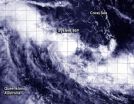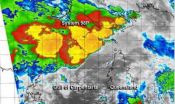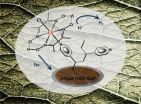(Press-News.org) There are two developing areas of tropical low pressure that lie east and west of Queensland, Australia. System 96P and System 98P, respectively. The MODIS instrument that flies aboard both NASA's Aqua and Terra satellites captured images of both tropical trouble-makers as each satellite passed overhead on March 7.
In the Coral Sea, part of the Southwestern Pacific Ocean, System 96P was just 125 nautical miles/143.8 miles/231.5 km north-northeast of Willis Island, Australia. It was centered near 14.3 south latitude and 150.6 east longitude. System 96P is moving in south-southwesterly direction toward Willis Island and the Queensland mainland. As a result, a Cyclone Watch is in effect for coastal areas from Cairns to Mackay.
NASA's Aqua satellite passed over developing System 96P in the Coral Sea on March 7 at 03:25 UTC when the Moderate Resolution Imaging Spectroradiometer or MODIS instrument captured a visible image of the storm. MODIS image showed the strongest thunderstorms were west and south of the center of circulation.
The Joint Typhoon Warning Center noted that animated multispectral satellite imagery revealed that the low-level circulation center is broad, and like the MODIS imagery, showed there are bands of thunderstorms wrapping into it, mostly from the southern and western quadrants. An image from the Advanced Scatterometer instrument called ASCAT provides evidence that the low is strengthening. ASCAT can measure surface winds and indicated that the low has 25 to 30 knot/28.7 to 34.5 mph/46.3 to 55.5 kph winds wrapping into the northern semi-circle.
Willis Island reported sustained winds that match ASCAT readings, southeasterly winds sustained between 25 to 30 knots.
The Australian Bureau of Meteorology expects System 96P to strengthen and approach the eastern Queensland coast near Bowen by 10 p.m. local time on March 9.
Second System Poised to Affect Queensland
To the west of Queensland in the northern Gulf of Carpentaria lies System 98P. That tropical low pressure area was centered near 9.8 south latitude and 138.4 east longitude about 175 nautical miles/201.4 miles/324.1 km north-northeast of Gove Airport, Australia.
Another MODIS instrument that flies aboard NASA's Terra satellite provided an infrared image of developing System 98P on March 7 at 15:55 UTC. The MODIS image showed that 98P had some strong convection and strong thunderstorms developing west of the center.
As System 98P continues to approach Queensland, a Cyclone Watch was declared for coastal areas from Kowanyama to Cape Grenville, including the Torres Trait Islands. The Australian Bureau of Meteorology expects this low to intensify before making landfall near Weipa at 10 p.m. local time on March 9.
The Joint Typhoon Warning Center or JTWC identified an area of persistent deep convection over the western semi-circle and curved bands of thunderstorms in the western quadrant of the storm. ASCAT imagery showed that the storm has an elongated circulation with primarily 20 to 25 knot/23.0 to 28.7 mph /37.0 to 46.3 kph winds. JTWC gives System 98P a medium chance for development in the next day.
INFORMATION:
For updates on the progression of these storms and forecasts for Queensland, visit the Australian Bureau of Meteorology website: http://www.bom.gov.au/cyclone/.
NASA satellites see double tropical trouble for Queensland, Australia
2014-03-07
ELSE PRESS RELEASES FROM THIS DATE:
The dark side of fair play
2014-03-07
We often think of playing fair as an altruistic behavior. We're sacrificing our own potential gain to give others what they deserve. What could be more selfless than that? But new research from Northeastern University assistant professor of philosophy Rory Smead suggests another, darker origin behind the kindly act of fairness.
Smead studies spite. It's a conundrum that evolutionary biologists and behavioral philosophers have been mulling over for decades, and it's still relatively unclear why the seemingly pointless behavior sticks around. Technically ...
Service is key to winery sales
2014-03-07
ITHACA, N.Y. – To buy, or not to buy? That is the question for the more than 5 million annual visitors to New York's wineries. Cornell University researchers found that customer service is the most important factor in boosting tasting room sales, but sensory descriptions of what flavors consumers might detect were a turn-off.
The findings stem from two studies on how the tasting room experience affects customer purchases and what wineries can do to create satisfied sippers, published in the current issue of the International Journal of Wine Business Research.
"On average, ...
Ever-so-slight delay improves decision-making accuracy
2014-03-07
NEW YORK, NY (March 7, 2014) — Columbia University Medical Center (CUMC) researchers have found that decision-making accuracy can be improved by postponing the onset of a decision by a mere fraction of a second. The results could further our understanding of neuropsychiatric conditions characterized by abnormalities in cognitive function and lead to new training strategies to improve decision-making in high-stake environments. The study was published in the March 5 online issue of the journal PLoS One.
"Decision making isn't always easy, and sometimes we make errors ...
Notre Dame chemists discover new class of antibiotics
2014-03-07
A team of University of Notre Dame researchers led by Mayland Chang and Shahriar Mobashery have discovered a new class of antibiotics to fight bacteria such as methicillin-resistant Staphylococcus aureus (MRSA) and other drug-resistant bacteria that threaten public health. Their research is published in the Journal of the American Chemical Society in an article titled "Discovery of a New Class of Non-beta-lactam Inhibitors of Penicillin-Binding Proteins with Gram-Positive Antibacterial Activity."
The new class, called oxadiazoles, was discovered in silico (by computer) ...
New theory on cause of endometriosis
2014-03-07
Changes to two previously unstudied genes are the centerpiece of a new theory regarding the cause and development of endometriosis, a chronic and painful disease affecting 1 in 10 women.
The discovery by Northwestern Medicine scientists suggests epigenetic modification, a process that enhances or disrupts how DNA is read, is an integral component of the disease and its progression. Matthew Dyson, research assistant professor of obstetrics and gynecology at Northwestern University Feinberg School of Medicine and and Serdar Bulun, MD, chair of obstetrics and gynecology ...
Bone turnover markers predict prostate cancer outcomes
2014-03-07
(SACRAMENTO, Calif.) —Biomarkers for bone formation and resorption predict outcomes for men with castration-resistant prostate cancer, a team of researchers from UC Davis and their collaborators have found. Their study, published online in the Journal of the National Cancer Institute, also found that the markers identified a small group of patients who responded to the investigational drug atrasentan. The markers' predictive ability could help clinicians match treatments with individual patients, track their effectiveness and affect clinical trial design.
Castration-resistant ...
Promising news for solar fuels from Berkeley Lab researchers at JCAP
2014-03-07
There's promising news from the front on efforts to produce fuels through artificial photosynthesis. A new study by Berkeley Lab researchers at the Joint Center for Artificial Photosynthesis (JCAP) shows that nearly 90-percent of the electrons generated by a hybrid material designed to store solar energy in hydrogen are being stored in the target hydrogen molecules.
Gary Moore, a chemist and principal investigator with Berkeley Lab's Physical Biosciences Division, led an efficiency analysis study of a unique photocathode material he and his research group have developed ...
Anti-psychotic medications offer new hope in the battle against glioblastoma
2014-03-07
Researchers at the University of California, San Diego School of Medicine have discovered that FDA-approved anti-psychotic drugs possess tumor-killing activity against the most aggressive form of primary brain cancer, glioblastoma. The finding was published in this week's online edition of Oncotarget.
The team of scientists, led by principal investigator, Clark C. Chen, MD, PhD, vice-chairman, UC San Diego, School of Medicine, division of neurosurgery, used a technology platform called shRNA to test how each gene in the human genome contributed to glioblastoma growth. ...
Agricultural fires across the Indochina landscape
2014-03-07
Agricultural fires are still burning in Indochina ten days after the last NASA web posting about the fires. This natural-color image, taken on March 07, 2014, by the Moderate Resolution Imaging Spectroradiometer, MODIS, aboard the Aqua satellite, shows a more comprehensive area of burning agricultural fires that stretch from Burma through to Laos and south throughout Thailand. Actively burning areas, detected by MODIS's thermal bands, are outlined in red.Fire is used in cropland areas for pest and weed control and to prepare fields for planting. Crop residue burning helps ...
NYU researchers find majority of Latinas are unaware of their risk of diabetes
2014-03-07
Approximately 5.5 million Latinas suffer from elevated fasting plasma glucose (FPG) and nearly 4 million of those women were never told by a healthcare provider they were at risk for diabetes, pre-diabetes, or were borderline for diabetes.
The study, "Latinas with Elevated Fasting Plasma Glucose: An Analysis Using NHANES 2009-2010 Data," led by Dr. Shiela M. Strauss, Associate Professor, New York University College of Nursing (NYUCN), points to the urgent need for alternate sites of opportunity for diabetes screenings. There is also a need for effective and culturally ...




